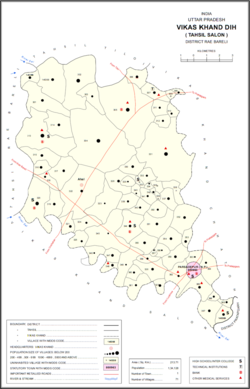Mau, Dih, Raebareli
Mau | |
|---|---|
Village | |
 Map showing Mau (#305) in Dih CD block | |
| Coordinates: 26°11′40″N 81°27′01″E / 26.194572°N 81.450304°E[1] | |
| Country | |
| State | Uttar Pradesh |
| District | Raebareli |
| Area | |
• Total | 15.441 km2 (5.962 sq mi) |
| Population (2011)[2] | |
• Total | 7,121 |
| • Density | 460/km2 (1,200/sq mi) |
| Languages | |
| • Official | Hindi |
| Time zone | UTC+5:30 (IST) |
| Vehicle registration | UP-35 |
Mau is a large village in Dih block of Rae Bareli district, Uttar Pradesh, India.[2] It is located on the road from Fursatganj to the Gukana ghat on the Ganges, 4 miles west of Nasirabad and 8 miles from Jais.[3] A road branches off at Mau and connects to Nasirabad.[3] To the northwest of the village is a large lake called the Bara Tal.[3]
As of 2011, Mau has a population of 7,121 people, in 1,371 households.[2] It has 4 primary schools and a maternity and child welfare centre.[2] It hosts markets twice per week, on Mondays and Thursdays.[4] The main items traded are cloth, grain, gur, ornaments, and vegetables.[2] Mau is the headquarters of a nyaya panchayat, which also includes 8 other villages.[5]
History
[edit]At the turn of the 20th century, Mau was described as a large agricultural village that was mainly notable for the size of its population.[3] As of 1901, it was home to 3,075 people, including 266 Muslims; Pasis formed a majority of the local cultivators.[3] The village was part of the taluqdari estate belonging to the Raja of Tiloi, although three small mahals were held in subsettlement by Kayasth proprietors.[3] Mau was the site of a police station until 1900, when it was moved to Nasirabad.[3] As of 1905, Mau had a post office, a school maintained by the Court of Wards, and a small bazar in the hamlet of Pura Lokai.[3]
The 1951 census recorded Mau as comprising 17 hamlets, with a total population of 3,014 people (1,561 male and 1,453 female), in 741 households and 700 physical houses.[6] The area of the village was given as 3,659 acres.[6] 85 residents were literate, 82 male and 3 female.[6] The village was listed as belonging to the pargana of Rokha and the thana of Nasirabad.[6]
The 1961 census recorded Mau as comprising 15 hamlets, with a total population of 3,349 people (1,748 male and 1,601 female), in 781 households and 768 physical houses.[4] The area of the village was given as 3,659 acres and it had a post office at that point.[4] Average attendance of the twice-weekly market was about 1,000 people.[4]
The 1981 census recorded Mau as having a population of 4,362 people, in 1,080 households, and having an area of 1,365.81 hectares.[7] The main staple foods were listed as wheat and rice.[7]
The 1991 census recorded Mau as having a total population of 4,957 people (2,547 male and 2,410 female), in 1,101 households and 1,096 physical houses.[5] The area of the village was listed as 1,544 hectares.[5] Members of the 0-6 age group numbered 979, or 18% of the total; this group was 50% male (487) and 50% female (492).[5] Members of scheduled castes made up 47% of the village's population, while no members of scheduled tribes were recorded.[5] The literacy rate of the village was 14.5% (636 men and 85 women).[5] 1,731 people were classified as main workers (1,387 men and 344 women), while 512 people were classified as marginal workers (60 men and 452 women); the remaining 2,714 residents were non-workers.[5] The breakdown of main workers by employment category was as follows: 1,040 cultivators (i.e. people who owned or leased their own land); 553 agricultural labourers (i.e. people who worked someone else's land in return for payment); 9 workers in livestock, forestry, fishing, hunting, plantations, orchards, etc.; 0 in mining and quarrying; 0 household industry workers; 74 workers employed in other manufacturing, processing, service, and repair roles; 4 construction workers; 25 employed in trade and commerce; 1 employed in transport, storage, and communications; and 25 in other services.[5]
References
[edit]- ^ "Geonames Search". Do a radial search using these coordinates here.
- ^ a b c d e f "Census of India 2011: Uttar Pradesh District Census Handbook - Rae Bareli, Part A (Village and Town Directory)" (PDF). Census 2011 India. pp. 393–409. Retrieved 15 October 2021.
- ^ a b c d e f g h Nevill, H.R. (1905). Rai Bareli: A Gazetteer, Being Volume XXXIX Of The District Gazetteers Of The United Provinces Of Agra And Oudh. Allahabad: Government Press. pp. 195–6, 200. Retrieved 15 October 2021.
- ^ a b c d Census 1961: District Census Handbook, Uttar Pradesh (39 - Raebareli District) (PDF). Lucknow. 1965. pp. 176, cii-ciii of section "Salon Tahsil". Retrieved 15 October 2021.
{{cite book}}: CS1 maint: location missing publisher (link) - ^ a b c d e f g h Census 1991 Series-25 Uttar Pradesh Part-XII B Village & Townwise Primary Census Abstract District Census Handbook District Raebareli (PDF). 1992. pp. xxiv–xxviii, 238–9. Retrieved 15 October 2021.
- ^ a b c d Census of India, 1951: District Census Handbook Uttar Pradesh (42 - Rae Bareli District) (PDF). Allahabad. 1955. pp. 164–5. Retrieved 15 October 2021.
{{cite book}}: CS1 maint: location missing publisher (link) - ^ a b Census 1981 Uttar Pradesh: District Census Handbook Part XIII-A: Village & Town Directory, District Rae Bareli (PDF). 1982. pp. 204–5. Retrieved 15 October 2021.

